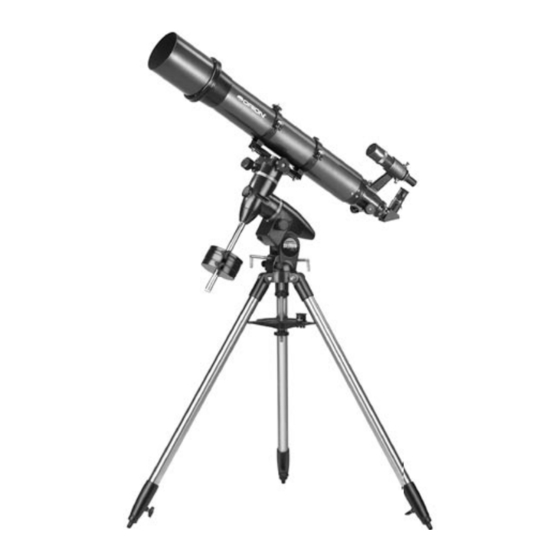
Table of Contents
Advertisement
Quick Links
Advertisement
Table of Contents

Subscribe to Our Youtube Channel
Summary of Contents for Orion SKYVIEW PRO 120 EQ
- Page 1 INSTRUCTION MANUAL Orion ® SkyView Pro 120 EQ ™ #9867 Equatorial Refractor Telescope Customer Support (800)-676-1343 E-mail: support@telescope.com Corporate Offices (831)-763-7000 P.O. Box 1815, Santa Cruz, CA 95061 Providing Exceptional Consumer Optical Products Since 1975 IN 189 Rev. B 04/05...
- Page 2 Safety thumbscrew Mounting plate securing knob Counterweight shaft Counterweights Counterweight lock knobs Tripod leg Leg lock knobs Figure 1. The SkyView Pro 120 EQ. Optical tube Tube rings Finder scope Finder scope bracket Eyepiece Star diagonal Focus wheel Right Ascension...
-
Page 3: Table Of Contents
4. Balancing the Telescope....5 5. Using Your Telescope ....6 6. - Page 4 Azimuth adjustment knobs Figure 2. Orient the equatorial mount so that the post on the tripod head lines up between the azimuth adjustment knobs on the equatorial mount. 1. Stand the tripod legs upright and spread the legs out as far as they will go.
-
Page 5: Installing The Finder Scope
(c) With the Dec. lock lever released, loosen the tube ring lock clamps a few turns and slide the telescope forward or back in the tube rings. (d) When the tube is balanced about the Dec. axis, it will not move when you let go. -
Page 6: Aligning The Finder Scope
Aligning the Finder Scope The SkyView Pro 120 EQ comes with a 8x40 achromatic find- er scope (Figure 3a). The number 8 means eight-times magni- fication and the 40 indicates a 40mm diameter front lens. The... -
Page 7: Setting Up And Using The Equatorial Mount
Use of 2" Eyepieces A feature of the SkyView Pro 120 EQ is its ability to use either 1.25" or 2" barrel-diameter eyepieces. At low magnifications, 2" eyepieces can give a wider field of view than standard 1.25"... -
Page 8: Polar Alignment
3. Loosen the Dec. lock lever and rotate the telescope’s opti- cal tube until it is parallel with the right ascension axis, as it is in Figure 6. - Page 9 Polar Alignment Using an Optional Polar Axis Finder Scope The SkyView Pro 120 EQ mount can be equipped with an optional polar axis finder scope (Figure 9a) which goes inside the right ascension axis of the mount. When properly aligned and used, it makes accurate polar alignment quick and easy to do.
- Page 10 Before you can use the knobs, you must manually “slew” the mount to point the telescope in the vicinity of the desired target. Do this by loos- ening the R.A. and Dec. lock levers and moving the telescope about the mount’s right ascension and declination axes.
- Page 11 So, the coordinates for the Orion Nebula listed in a star atlas will look like this: R.A. 5h 35.4m Dec. –5° 27' That’s 5 hours and 35.4 minutes in right ascension, and -5...
-
Page 12: Observing Tips
7. Astronomical Observing For many users, the SkyView Pro 120 EQ telescope will be a major leap into the world of amateur astronomy. This section is intended to get you ready for your voyages through the night sky. -
Page 13: What To Expect
Allow at least 30 minutes for your SkyView Pro 120 EQ to equilibrate. If the scope has more than a 40° temperature adjustment, allow an hour or more. In the winter, storing the telescope outdoors in a shed or garage greatly reduces the amount of time needed for the optics to stabilize. -
Page 14: Deep-Sky Objects
Venus, Mars, Jupiter, and Saturn are the brightest objects in the sky after the Sun and the Moon. Your SkyView Pro 120 EQ is capable of showing you these planets in some detail. Other planets may be visible but will likely appear starlike. -
Page 15: Piggyback Photography
8. Astrophotography Several different types of astrophotography can be success- fully attempted with the SkyView Pro 120 EQ. Moon Photography This is perhaps the simplest form of astrophotography, as no motor drive is required. All that is needed is a T-ring for your specific camera model. -
Page 16: Collimating (Aligning The Optics)
Once only one circular ring is visible, no further collimation adjustments are needed. Your SkyView Pro 120 EQ is now collimated. You should not need to align the optics again unless the telescope is roughly handled. -
Page 17: Cleaning Lenses
Keep the dust cover on the front of the telescope when not in use. Your SkyView Pro 120 EQ requires very little mechanical maintenance. The optical tube is aluminum and has a smooth painted finish that is fairly scratch-resistant. -
Page 20: One-Year Limited Warranty
One-Year Limited Warranty This Orion SkyView Pro 120 EQ is warranted against defects in materials or workmanship for a period of one year from the date of purchase. This warranty is for the benefit of the original retail purchaser only. During this warranty period Orion Telescopes & Binoculars will repair or replace, at Orion’s option, any warranted instrument that proves to be defective, provided it is returned postage...
















Need help?
Do you have a question about the SKYVIEW PRO 120 EQ and is the answer not in the manual?
Questions and answers